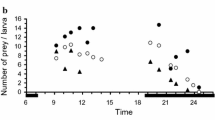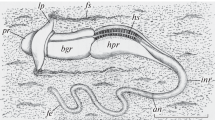Abstract
Collections of Branchiostoma lanceolatum (Pallas) made in mid-May and mid-July at Helgoland before and after spawning have established that the larvae leave the amphioxus ground about June and therefore presumably become planktonic. Metamorphosing larvae and young adults can be collected on the ground in late August and early September and are either the same larvae returning, or others from a neighbouring ground within the same circulating current system. An examination of the gut contents of 67 larvae collected from the plankton at Helgoland in August showed that 30% of the animals had ingested calanoid copepods or other organic material of a size similar to that of the larval mouth. A few larvae had also taken small particles evidently by a ciliary mechanism. In 50% of the larvae the gut was empty. It has been found that, in addition to a muscular mouth and gill bars richly supplied with nerves, both the gut wall and the body wall are muscular and capable of passing, by peristalsis, large food masses that distend the body. The visceral muscles of the larva resemble the coelomyarian fibres of the Nematoda. The larva appears, therefore, to be both microphagous and macrophagous. Evidence from the swimming behaviour and from reports of the vertical distribution of larvae in the sea is discussed. It is suggested that the larvae normally swim upward with the mouth and gills closed and then sink passively in the horizontal position with the pharynx expanded and the open mouth directed downward. In the event of large organism such as a copepod or a mass of organic material coming into contact with the adhesive lower left surface of the larva, it could be captured by the mobile lower lip and engulfed. The straightening of the larval tail, the great increase in the number of eyecups and the growth of the metapleura at metamorphosis are suggested as factors leading to the settlement of the young adult. Attention is drawn to the possible significance of the structure of the larva in interpreting the relationships of the cephalochordates.
Similar content being viewed by others
Literature cited
Barrington, E. J. W.: The digestive system of Amphioxus (Branchiostoma) lanceolatus. Phil. Trans. R. Soc. (Ser. B.) 228, 269–312 (1937).
— The biology of Hemichordata and Protochordata, 176 pp. Edinburgh and London: Oliver & Boyd (1965).
Bone Q.: The asymmetry of the larval amphioxus. Proc. zool. Soc. Lond. 130, 289–293 (1958).
— The central nervous system in larval acraniates. Q. Jl microsc. Sci. 100, 509–527 (1959).
Chin, T. G.: Studies on the biology of the Amoy amphioxus Branchiostoma belcheri Gray. Phillipp. J. Sci. 75, 369–424 (1941).
Courtney, Q. A. M. and J. E. Webb: The effects of the cold winter of 1962/63 on the Helgoland population of Branchiostoma lanceolatum (Pallas). Helgoländer wiss. Meeresunters. 10, 301–312 (1964).
Flood, P. R.: A peculiar mode of muscular innervation in amphioxus. Light and electron microscopic studies of the so-called ventral roots. J. comp. Neurol. 126, 181–217 (1966).
Gibson, H. O. S.: The Percy Salden Trust Expedition to the Indian Ocean in 1905, No. 9. The Cephalochorda: Amphioxides. Trans. Linn. Soc. Lond. (Zool) 13, 213–256 (1910).
Goodrich, E. S.: The development of the club-shaped gland in amphioxus. Q. Jl microsc. Sci. 74, 155–164 (1930).
Lankester, E. R. and A. Willey: The development of the atrial chamber of amphioxus. Q. Jl microsc. Sci. 31, 445–466 (1890).
Oeton, J. H.: The ciliary mechanisms on the gill and the mode of feeding in amphioxus, ascidians, and Solenomya togata. J. mar. biol. Ass. U.K. 10, 19–49 (1913).
— On a hermaphrodite specimen of amphioxus with notes on experiments in rearing amphioxus. J. mar. biol. Ass. U.K. 10, 506–512 (1914).
Rice, H. J.: Observations upon the habits, structure and development of Amphioxus lanceolatus. Am. Nat. 14, 1–19 and 73–95 (1880).
van Wijhe, J. W.: On the temporary presence of the primary mouth-opening in the larva of amphioxus, and the occurrence of three postoral papillae, which are probably homologous with those of the larva of Ascidians. Proc. K. ned. Akad. Wet. Amsterdam. 29, 286–295 (1926).
—: Observations on the adhesive apparatus and the function of the ilio-colon ring in the living larva of Amphioxus in the growth-period. Proc. K. ned. Akad. Wet. 30, 99–1003 (1927).
Webb, J. E.: The ecology of Lagos lagoon 3. The life history of Branchiostoma nigeriense Webb. Phil. Trans. R. Soc. (Ser. B.) 241, 335–353 (1958).
— Altertümlich oder modern, ein neuer Blick auf Amphioxus. Umschau 13, 410–411 (1968).
Webb, J. E. Seasonal changes in the distribution of Branchiostoma lanceolatum (Pallas) at Helgoland. Read in the third European Symposium on Marine Biology 1968 at Arcachon; to be printed in 1969.
— and M. B. Hill: The ecology of Lagos lagoon 4. On the reactions of Branchiostoma nigeriense Webb to its environment. Phil. Trans. R. Soc. (Ser. B.) 241, 355–391 (1958).
Wickstead, J. H. and Q. Bone: Ecology of acraniate larvae. Nature, Lond. 184, 1849–1851 (1959).
Willey, A.: The later larval development of amphioxus. Q. Jl microsc. Sci. 32, 183–234 (1891).
Author information
Authors and Affiliations
Additional information
Communicated by J. E. Smith, Plymouth
Rights and permissions
About this article
Cite this article
Webb, J.E. On the feeding and behaviour of the larva of Branchiostoma lanceolatum . Marine Biology 3, 58–72 (1969). https://doi.org/10.1007/BF00355593
Accepted:
Issue Date:
DOI: https://doi.org/10.1007/BF00355593




